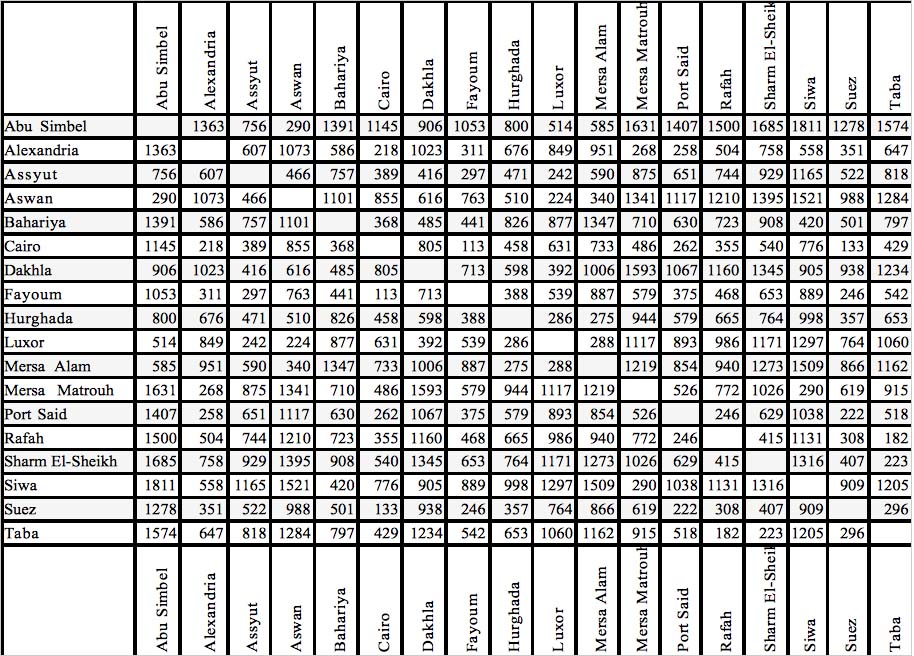Official Name: Arab Republic of Egypt
Area: 1,001,450 km2
You can find a lot of travel information about Egypt in tourist guide books. Here we give you an insider’s view and sometimes even personal advice based on our experience. You will also find some links to useful web pages.
The desert is divided into the Libyan Desert (also known as the Western Desert) in the west, a part of the Sahara, and the Arabian Desert (also called the Eastern Desert), which borders the Red Sea and the Gulf of Suez in the east. The Sinai Peninsula consists of sandy desert in the north and rugged mountains in the south, with summits looming more than 2,000 m above the Red Sea and the highest peak being Mount Catherine at 2,650 m.

http://www.beconvinced.com/archive/en/main.php
http://www.islamhouse.com/p/165689
http://www.christianity-guide.com/christianity/coptic_christianity.htm
You can read more about Egyptian history at:
http://www.library.exploreregypt.com/
http://www.ancientegypt.co.uk/menu.html
http://www.mnsu.edu/emuseum/prehistory/egypt/history/history.html
http://www.osirisnet.net/
There are two main seasons: the hot season from May to October and the cool season from November to April.
Average temperatures:
Cairo |
|
|
|
|
|
|
|
|
|
|
|
|
|
Jan |
Feb |
Mar |
Apr |
May |
Jun |
Jul |
Aug |
Sep |
Oct |
Nov |
Dec |
Avg. Temperature |
13 |
15 |
17 |
20 |
24 |
27 |
28 |
28 |
27 |
23 |
19 |
15 |
Avg. Max Temperature |
18 |
20 |
22 |
27 |
31 |
33 |
34 |
34 |
33 |
29 |
24 |
20 |
Avg. Min Temperature |
8 |
10 |
11 |
14 |
18 |
21 |
22 |
23 |
21 |
18 |
14 |
10 |
Avg. No. of Rain Days |
1 |
1 |
1 |
0 |
0 |
0 |
0 |
0 |
0 |
0 |
1 |
0 |
|
|
|
|
|
|
|
|
|
|
|
|
|
Luxor |
|
|
|
|
|
|
|
|
|
|
|
|
|
Jan |
Feb |
Mar |
Apr |
May |
Jun |
Jul |
Aug |
Sep |
Oct |
Nov |
Dec |
Avg. Temperature |
14 |
16 |
20 |
25 |
30 |
32 |
33 |
32 |
30 |
26 |
20 |
15 |
Avg. Max Temperature |
22 |
24 |
28 |
34 |
38 |
40 |
41 |
40 |
39 |
34 |
28 |
23 |
Avg. Min Temperature |
6 |
7 |
11 |
16 |
21 |
22 |
24 |
24 |
22 |
18 |
11 |
6 |
Avg. No. of Rainy Days |
0 |
0 |
0 |
0 |
0 |
0 |
0 |
0 |
0 |
0 |
0 |
0 |
|
|
|
|
|
|
|
|
|
|
|
|
|
Aswan |
|
|
|
|
|
|
|
|
|
|
|
|
|
Jan |
Feb |
Mar |
Apr |
May |
Jun |
Jul |
Aug |
Sep |
Oct |
Nov |
Dec |
Avg. Temperature |
16 |
17 |
21 |
27 |
32 |
33 |
34 |
34 |
32 |
27 |
21 |
16 |
Avg. Max Temperature |
23 |
24 |
28 |
35 |
39 |
41 |
41 |
41 |
40 |
35 |
28 |
23 |
Avg. Min Temperature |
9 |
10 |
13 |
19 |
23 |
25 |
27 |
27 |
25 |
21 |
15 |
10 |
Avg. No. of Rainy Days |
0 |
0 |
0 |
0 |
0 |
0 |
0 |
0 |
0 |
0 |
0 |
0 |
|
|
|
|
|
|
|
|
|
|
|
|
|
Sharm El-Sheikh |
|
|
|
|
|
|
|
|
|
|
|
|
|
Jan |
Feb |
Mar |
Apr |
May |
Jun |
Jul |
Aug |
Sep |
Oct |
Nov |
Dec |
Avg. Temperature |
17 |
18 |
21 |
25 |
28 |
31 |
32 |
33 |
30 |
27 |
22 |
19 |
Avg. Max Temperature |
21 |
22 |
25 |
29 |
33 |
36 |
37 |
37 |
35 |
30 |
26 |
23 |
Avg. Min Temperature |
13 |
13 |
17 |
20 |
24 |
26 |
28 |
28 |
26 |
23 |
19 |
15 |
Avg. No. of Rainy Days |
0 |
0 |
0 |
0 |
0 |
0 |
0 |
0 |
0 |
0 |
0 |
0 |
|
|
|
|
|
|
|
|
|
|
|
|
|
Alexandria |
|
|
|
|
|
|
|
|
|
|
|
|
|
Jan |
Feb |
Mar |
Apr |
May |
Jun |
Jul |
Aug |
Sep |
Oct |
Nov |
Dec |
Avg. Temperature |
13 |
13 |
15 |
18 |
21 |
24 |
26 |
27 |
25 |
22 |
18 |
14 |
Avg. Max Temperature |
18 |
18 |
20 |
23 |
26 |
28 |
30 |
30 |
30 |
27 |
23 |
20 |
Avg. Min Temperature |
8 |
8 |
10 |
12 |
17 |
21 |
22 |
23 |
21 |
18 |
13 |
9 |
Avg. No. of Rainy Days |
5 |
3 |
2 |
0 |
0 |
0 |
0 |
0 |
0 |
1 |
3 |
3 |
|
|
|
|
|
|
|
|
|
|
|
|
|

